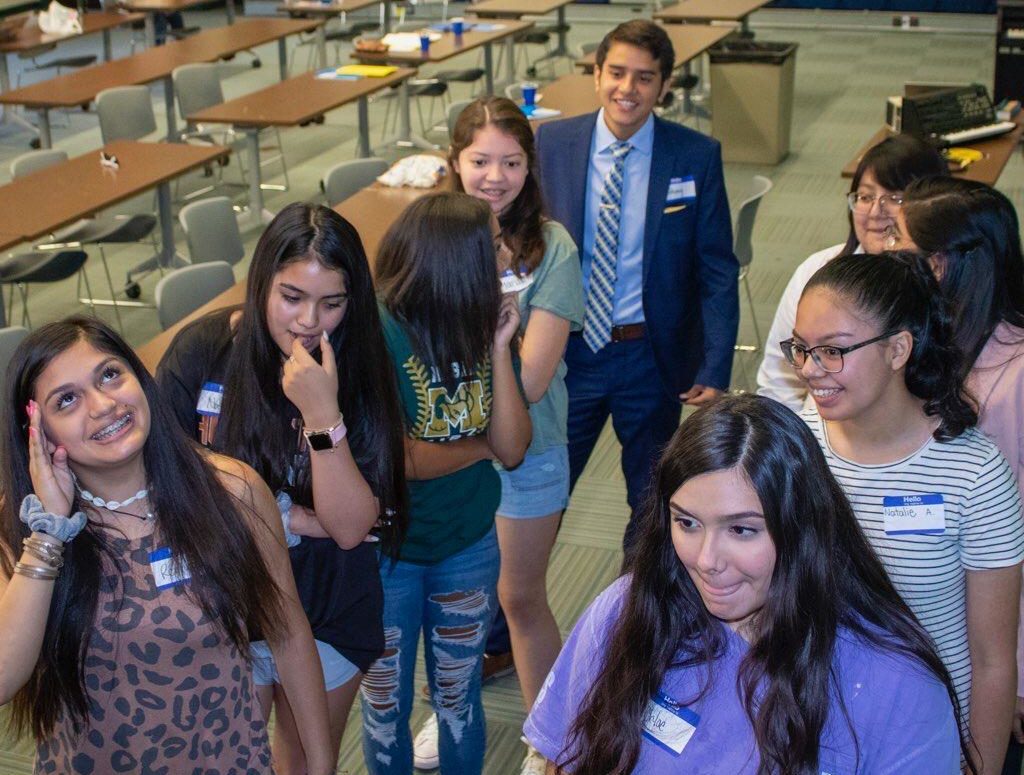
DFW Youth Success
Students in Fort Worth, Texas, gather at the summer college prep workshop created by students Isaac Espinal and Hannah Sturgill to broaden access to college counseling. They were among young people who identified problems and developed solutions as part of the Power of Youth Challenge.
When Isaac Espinal was in the eighth grade in Fort Worth, Texas, he compared his local public school with a nearby private school. Paschal High School had classes of 25 or more students, compared with 15 to 18 students in the private Trinity Valley School. Instead of a graduating class of perhaps 400, the private school had fewer than 100.
He saw the personal attention available at the private school and how students were groomed for college.
“I applied to Trinity Valley and I got a full scholarship,” he said.
Last year, as a senior there, he decided to address the inequalities he saw in educational opportunity. He and fellow student Hannah Sturgill created a youth-led nonprofit to coach and support students toward college or other higher education. Forty students from three public high schools met every Saturday in July and August for college counseling, test prep assistance and hearing from current college students how they made it.
Called DFW Youth Success, the project was one of 10 winners in the 2019 America’s Promise Alliance Power of Youth Challenge, which challenges youth to identify an injustice in their community and develop a solution. America’s Promise Alliance is a nonprofit organization that brings together a network of other organizations and people to improve opportunity for youth.
Power of Youth Challenge winners have shown “exceptional passion, creativity, empathy and determination to make their communities a better place,” said John Gomperts, president and CEO of America’s Promise, in a statement. “What’s more … they’re empowering other young people to go out there and do the same.”
Espinal spent several months researching what students needed in order to make access to higher education more equitable.
“The research phase was the biggest and hardest thing to do,” he said. He visited some of the strongest and weakest schools in his district and interviewed students and high school counselors. They requested help in having a consistent college focus, he said.
The Saturday workshops, which will resume in January, help students clarify their goals and interests, as well as stay on track in the college testing and application process, Espinal said. Students can get connected to internships and opportunities they otherwise might not learn about.
Another winner in the Power of Youth Challenge, Patterson, N.Y., student Riley Damiano, started the Blue Lollipop Project, which raised $20,000 for child cancer research. Prompted by a child with cancer who loved blue lollipops, it has sent 20,000 “blue smiles” to children with cancer.
In Washington, D.C., the Pathways 2 Power Focus Group co-founded by student Lauryn Renford leads discussions on violence and how to change the mindset that sees violence as natural.
In Honolulu, Hawaii, Dyson Chee has made presentations to more than 2,000 people about how plastics are polluting the ocean. Chee led a campaign to replace single-use plastic straws with stainless steel ones.
A total of 86 projects were submitted in the Power of Youth Challenge, which was announced in December 2018. The entrants received $250 each to implement their projects over six months. The top 10 projects, chosen by youth leaders at Peace First, received grants of $1,000 each. Funds were provided by the Charles Stewart Mott Foundation.
The goal of the Power of Youth Challenge is to encourage youth leadership and to connect young people with ways to meet the needs of their communities, according to America’s Promise. It’s also part of the organization’s goal to promote youth voice locally and nationally.





























